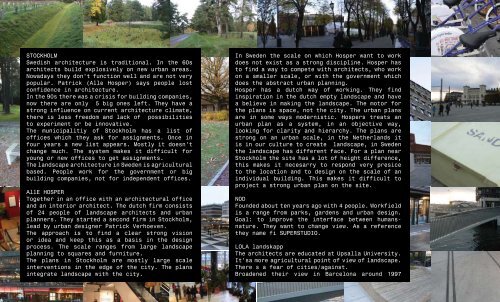this book
this book
this book
Create successful ePaper yourself
Turn your PDF publications into a flip-book with our unique Google optimized e-Paper software.
STOCKHOLM<br />
Swedish architecture is traditional. In the 60s<br />
architects build explosively on new urban areas.<br />
Nowadays they don’t function well and are not very<br />
popular. Patrick (Alle Hosper) says people lost<br />
confidence in architecture.<br />
In the 90s there was a crisis for building companies,<br />
now there are only 5 big ones left. They have a<br />
strong influence on current architecture climate,<br />
there is less freedom and lack of possibilities<br />
to experiment or be innovative.<br />
The municipalitiy of Stockholm has a list of<br />
offices which they ask for assignments. Once in<br />
four years a new list appears. Mostly it doesn’t<br />
change much. The system makes it difficult for<br />
young or new offices to get assignments.<br />
The landscape architecture in Sweden is agricultural<br />
based. People work for the government or big<br />
building companies, not for independent offices.<br />
AllE HOSPER<br />
Together in an office with an architectural office<br />
and an interior architect. The dutch firm consists<br />
of 24 people of landscape architects and urban<br />
planners. They started a second firm in Stockholm,<br />
lead by urban designer Patrick Verhoeven.<br />
The approach is to find a clear strong vision<br />
or idea and keep <strong>this</strong> as a basis in the design<br />
process. The scale ranges from large landscape<br />
planning to squares and furniture.<br />
The plans in Stockholm are mostly large scale<br />
interventions in the edge of the city. The plans<br />
integrate landscape with the city.<br />
In Sweden the scale on which Hosper want to work<br />
does not exist as a strong discipline. Hosper has<br />
to find a way to compete with architects, who work<br />
on a smaller scale, or with the government which<br />
does the abstract urban planning.<br />
Hosper has a dutch way of working. They find<br />
inspiration in the dutch empty landscape and have<br />
a believe in making the landscape. The motor for<br />
the plans is space, not the city. The urban plans<br />
are in some ways modernistic. Hospers treats an<br />
urban plan as a system, in an objective way,<br />
looking for clarity and hierarchy. The plans are<br />
strong on an urban scale, in the Netherlands it<br />
is in our culture to create landscape, in Sweden<br />
the landscape has different face. For a plan near<br />
Stockholm the site has a lot of height difference,<br />
<strong>this</strong> makes it necesarry to respond very presice<br />
to the location and to design on the scale of an<br />
individual building. This makes it difficult to<br />
project a strong urban plan on the site.<br />
NOD<br />
Founded about ten years ago with 4 people. Workfield<br />
is a range from parks, gardens and urban design.<br />
Goal: to improve the interface between humansnature.<br />
They want to change view. As a reference<br />
they name fi SUPERSTUDIO.<br />
LOLA landskapp<br />
The architects are educated at Upsalla University.<br />
It’sa more agricultural point of view of landscape.<br />
There s a fear of cities/against.<br />
Broadened their view in Barcelona around 1997


